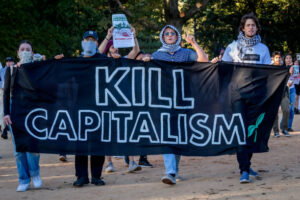Drive down the Main Boulevard and you’ll see the road surrounded by little cafes and restaurants offering cuisines from all over the world. For the overpriced, supposedly best desi food you’ll have to make your way into what was once the ‘heart’ of Lahore, the heart that has now been forced into the encroached lands of a housing society that has become a city of its own. When you make your way down from the third floor of the Emporium Mall in Johar Town, you notice a big window with an atrociously disgusting sight. A landfill, shopping bags and various forms of kachra piled up in an empty plot. This is where the working-class families park their bikes. That’s right, the working class that helped in the very ‘beautification’ and ‘development of the city doesn’t even get a spot in the mall’s covered parking lot. Whether it is Emporium or Packages Mall, or another one of those bougie Lahore elite commercial zones, you’ll find the area littered with western brands. Whether it’s clothing or food, gift stores or car dealerships, once you’re inside a mall you could be anywhere in the world. Something that Lahore is particularly known for, however, is its food culture. The postcolonial notions of gentrification, Hybridity and appropriation give rise to a new food culture in Lahore, one that transcends the boundaries of Punjab.
Gentrification mimics colonization. It is an economic ploy that starts off by repairing and rebuilding and ends in exploitation and displacement. By introducing better housing and commercializing poor urban areas, it seeks to attract wealthier people and ends up displacing the original inhabitants of the area. It insists on disciplining the poor through the acquisition of space by making it ‘better.’ The street vendors, the stalls and local markets get replaced by plazas and malls, people are driven out of their homes and snatched off their sources of income. Strip the city off of its cultural landscape and what is left behind is nothing but a hollow, gentrified postcolonial structure. The gentrification has not only eradicated Lahore’s cultural landscape but also its food culture. The gentrification of food has given a rich, expensive makeover to the poor man’s sustenance. A mazdoor’s morning tea is now ‘tandoori chai,’ almost double of its original cost. The ten-rupee roti/ naan is now a fancy ‘Nutella naan’ or a ‘pizza naan,’ something he can neither afford nor has the taste for. The rainy-day snack, samosa is now an unnecessary ‘smores samosa.’ First, we drive the people out of their homes, then we make their food so unapproachable that they are left to starve. But these businesses continue to thrive because the rich kids can finally enjoy the food that was too embarrassing for them to enjoy before because the makeover has made it ‘cool’ and ‘hip.’
For Bhabha, it is the ‘in between’ space which he calls the Third Space that carries the culture. It is in this space that a cross-cultural exchange of ideas occurs, giving rise to Hybridity. The Pakistani diaspora can be seen as this ‘in between’ space where a cross-cultural exchange of food occurs, giving rise to a Hybrid food culture. The consumption of food from one’s homeland eliminates the postcolonial phenomenon of detachment in the diaspora subject. It is through the consumption of such cuisine that the diaspora feels a sense of belonging. It is the flavour, the ingredients and the spices that evoke memory and emotions associated with one’s homeland. It is through the interaction with the Indian cuisine that a hybrid ‘mango lassi’ or a ‘chicken tikka masala’ is born and welcomed as a Pakistani dish by the diaspora, one which remains absent at home.
The postcolonial notion of appropriation builds on the idea of enabling a postcolonial state to use the tools introduced by the colonizer to their own advantage. Spivak emphasizes on the idea of western intellectuals speaking for the subaltern rather than letting the subaltern speak for themselves. However, it is through the appropriation of globalized cuisines that the subaltern speaks in terms of fusing flavours with his colonizer’s food and calls it their own. It is through ‘masala omelettes,’ ‘tikka pizza’ and the Pakistani-Chinese cuisine that a new food culture is born out of appropriating various cuisines of the world. In this appropriation, the postcolonial state is able to show its colonizer that it took their food, their leftover violence and the essence of their country and made it his own by delivering a new food culture.
Culture and identity play a crucial role in our context as a postcolonial nation. The evolution of food culture is not organic, it is a resultant of colonial oppression. The evolved food culture of Lahore leads us to question the ‘true’ Lahori culture and identity. What is left of the food culture, that we take so much pride in, to truly call our own? The emerging food culture leaves the city in a divide. While some embrace the food culture that is the resultant of gentrification, hybridity and appropriation, the rest latch on to their Original food cultures, one that they can afford. Food has become more than mere sustenance. The sort of food one consumes is seen as a choice of lifestyle and a status symbol. To what extent would it be fair for Lahore to continue to claim the food as its own? From the city’s architecture to the food we consume, what truly is our own?




